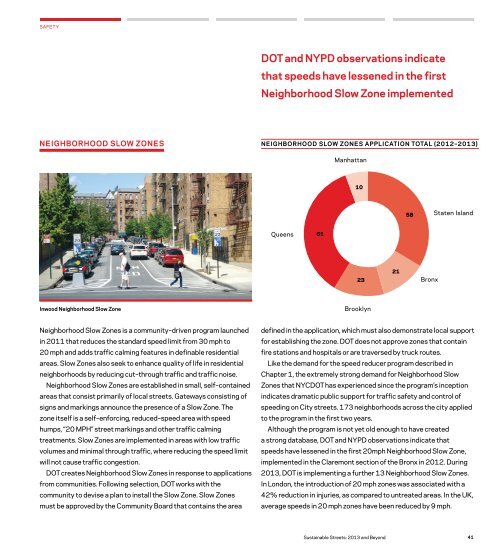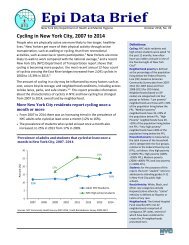2013-dot-sustainable-streets-lowres
2013-dot-sustainable-streets-lowres
2013-dot-sustainable-streets-lowres
You also want an ePaper? Increase the reach of your titles
YUMPU automatically turns print PDFs into web optimized ePapers that Google loves.
SAFETYDOT and NYPD observations indicatethat speeds have lessened in the firstNeighborhood Slow Zone implementedNEIGHBORHOOD SLOW ZONESNEIGHBORHOOD SLOW ZONES APPLICATION TOTAL (2012–<strong>2013</strong>)Manhattan1058Staten IslandQueens612321BronxInwood Neighborhood Slow ZoneBrooklynNeighborhood Slow Zones is a community–driven program launchedin 2011 that reduces the standard speed limit from 30 mph to20 mph and adds traffic calming features in definable residentialareas. Slow Zones also seek to enhance quality of life in residentialneighborhoods by reducing cut–through traffic and traffic noise.Neighborhood Slow Zones are established in small, self–containedareas that consist primarily of local <strong>streets</strong>. Gateways consisting ofsigns and markings announce the presence of a Slow Zone. Thezone itself is a self–enforcing, reduced–speed area with speedhumps, “20 MPH” street markings and other traffic calmingtreatments. Slow Zones are implemented in areas with low trafficvolumes and minimal through traffic, where reducing the speed limitwill not cause traffic congestion.DOT creates Neighborhood Slow Zones in response to applicationsfrom communities. Following selection, DOT works with thecommunity to devise a plan to install the Slow Zone. Slow Zonesmust be approved by the Community Board that contains the areadefined in the application, which must also demonstrate local supportfor establishing the zone. DOT does not approve zones that containfire stations and hospitals or are traversed by truck routes.Like the demand for the speed reducer program described inChapter 1, the extremely strong demand for Neighborhood SlowZones that NYCDOT has experienced since the program’s inceptionindicates dramatic public support for traffic safety and control ofspeeding on City <strong>streets</strong>. 173 neighborhoods across the city appliedto the program in the first two years.Although the program is not yet old enough to have createda strong database, DOT and NYPD observations indicate thatspeeds have lessened in the first 20mph Neighborhood Slow Zone,implemented in the Claremont section of the Bronx in 2012. During<strong>2013</strong>, DOT is implementing a further 13 Neighborhood Slow Zones.In London, the introduction of 20 mph zones was associated with a42% reduction in injuries, as compared to untreated areas. In the UK,average speeds in 20 mph zones have been reduced by 9 mph.Sustainable Streets: <strong>2013</strong> and Beyond41



